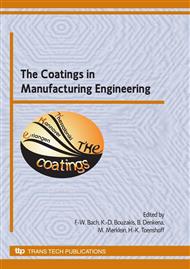p.41
p.49
p.57
p.65
p.73
p.81
p.89
p.97
p.107
Physico-Chemical Aspects of Surface Activation during Fluxless Brazing in Shielding-Gas Furnaces
Abstract:
Continuous process brazing in shielding-gas furnaces is tailor-made for manufacturing mass production components by means of brazing technology. Which brazing tasks can actually be carried out by a shielding-gas furnace, depend on many ancillary conditions. In particular these are, besides the component size and joint geometry, the base materials and brazing filler metals as well as the material specific process parameters which are to be maintained in a continuous furnace in order that a process assured brazing can be guaranteed. In this context, the activation of the component's surfaces play a central role for wetting with the braze melt. Within the scope of this contribution, the variables and ancillary conditions concerning this matter are presented and discussed using the brazing process on stainless steels as an example.
Info:
Periodical:
Pages:
73-80
Citation:
Online since:
May 2010
Authors:
Price:
Сopyright:
© 2010 Trans Tech Publications Ltd. All Rights Reserved
Share:
Citation:


